Overview
Tyk enables you to modify header information when a response is proxied back to the client. This can be very useful in cases where you have an upstream API that potentially exposes sensitive headers that you need to remove. There are two options for this:- API-level modification that is applied to responses for all requests to the API
- endpoint-level modification that is applied only to responses for requests to a specific endpoint
Use Cases
Customizing responses for specific clients
A frequent use case for response header transformation is when a client requires specific headers for their application to function correctly. For example, a client may require a specific header to indicate the status of a request or to provide additional information about the response.Adding security headers
The response header transform allows you to add security headers to the response to protect against common attacks such as cross-site scripting (XSS) and cross-site request forgery (CSRF). Some security headers may be required for compliance with industry standards and, if not provided by the upstream, can be added by Tyk before forwarding the response to the client.Adding metadata to response headers
Adding metadata to response headers can be useful for tracking and analyzing API usage, as well as for providing additional information to clients. For example, you may want to add a header that indicates the version of the API being used or the time taken to process the request.Modifying response headers for dynamic performance optimization
You can use response header transformation to dynamically optimize the performance of the API. For example, you may want to indicate to the client the maximum number of requests that they can make in a given time period. By doing so through the response headers, you can perform dynamic optimization of the load on the upstream service without triggering the rate limiter and so avoiding errors being sent to the client.Working
The response header transform can be applied per-API or per-endpoint; each has a separate entry in the API definition so that you can configure both API-level and endpoint-level transforms for a single API. The middleware is configured with a list of headers to delete from the response and a list of headers to add to the response. Each header to be added to the response is configured as a key:value pair.- the “delete header” functionality is intended to ensure that any header in the delete list is not present once the middleware completes. If a header in the delete list is not present in the upstream response, the middleware will ignore the omission
- the “add header” functionality will capitalize any header name provided. For example, if you configure the middleware to append
x-request-idit will be added to the response asX-Request-Id
Injecting dynamic data into headers
You can enrich the response headers by injecting data from context variables or session objects into the headers.- context variables, extracted from the request at the start of the middleware chain, can be injected into added headers using the
$tyk_context.namespace - session metadata, from the Tyk Session Object linked to the request, can be injected into added headers using the
$tyk_meta.namespace - values from key-value (KV) storage can be injected into added headers using the notation appropriate to the location of the KV store
Using Tyk OAS
Tyk’s response header transform middleware enables you to append or delete headers on responses received from the upstream service before sending them to the client. There are two options for this:- API-level modification that is applied to all responses for the API
-
endpoint-level modification that is applied only to responses from a specific endpoint
If both API-level and endpoint-level middleware are configured, the endpoint-level transformation will be applied first.
API Definition
The API-level and endpoint-level response header transforms have a common configuration but are configured in different sections of the API definition.API-level transform
To append headers to, or delete headers from, responses from all endpoints defined for your API you must add a newtransformResponseHeaders object to the middleware.global section of the Tyk OAS Extension (x-tyk-api-gateway) in your Tyk OAS API Definition.
You only need to enable the middleware (set enabled:true) and then configure the details of headers to add and those to remove.
For example:
X-Staticwith the valuefoobarX-Request-IDwith a dynamic value taken from therequest_idcontext variableX-User-IDwith a dynamic value taken from theuidfield in the session metadata
X-Secret
Endpoint-level transform
The design of the Tyk OAS API Definition takes advantage of theoperationId defined in the OpenAPI Document that declares both the path and method for which the middleware should be added. Endpoint paths entries (and the associated operationId) can contain wildcards in the form of any string bracketed by curly braces, for example /status/{code}. These wildcards are so they are human readable and do not translate to variable names. Under the hood, a wildcard translates to the “match everything” regex of: (.*).
The response header transform middleware (transformResponseMethod) can be added to the operations section of the Tyk OAS Extension (x-tyk-api-gateway) in your Tyk OAS API Definition for the appropriate operationId (as configured in the paths section of your OpenAPI Document).
You only need to enable the middleware (set enabled:true) and then configure the details of headers to add and those to remove.
For example:
GET requests to the /status/200 endpoint. Any response received from the upstream service following a request to that endpoint will have the X-Static header removed and the X-Secret and X-New headers added (with values set to the-secret-key-is-secret and another-header).
The configuration above is a complete and valid Tyk OAS API Definition that you can import into Tyk to try out the endpoint-level response header transform.
Combining API-level and Endpoint-level transforms
If the example API-level and endpoint-level transforms are applied to the same API, then theX-Secret header will be added (by the endpoint-level transform first) and then removed (by the API-level transform). Subsequently, the result of the two transforms for a call to GET /status/200 would be to add four headers:
X-Request-IDX-User-IDX-StaticX-New
API Designer
Adding and configuring the transforms to your API endpoints is easy when using the API Designer in the Tyk Dashboard, simply follow these steps:Adding an API-level transform
From the API Designer on the Settings tab, after ensuring that you are in edit mode, toggle the switch to Enable Transform response headers in the Middleware section: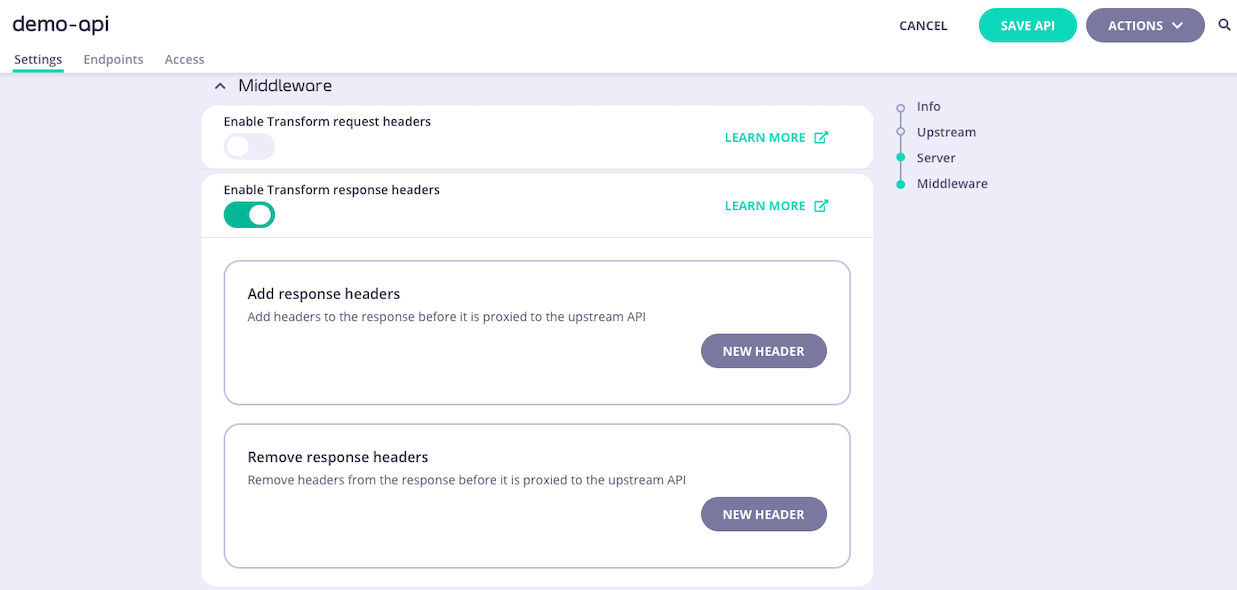
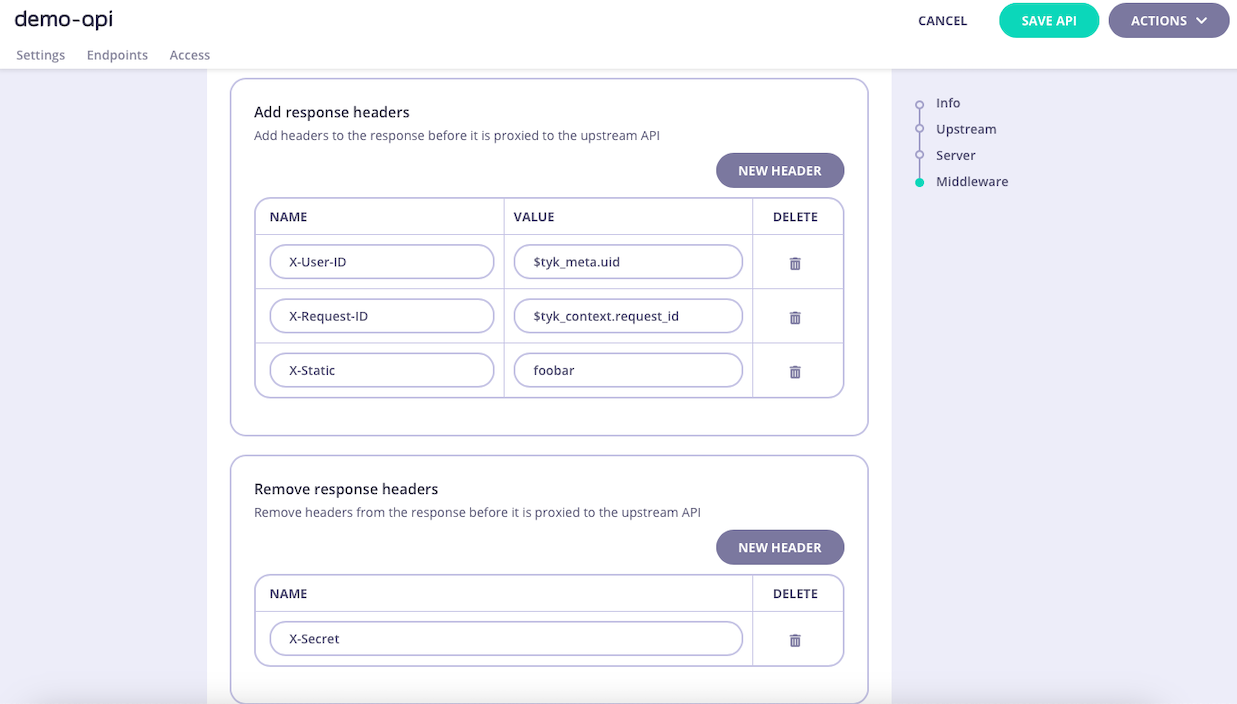
Adding an endpoint level transform
-
Add an endpoint
From the API Designer add an endpoint that matches the path and method to which you want to apply the middleware.
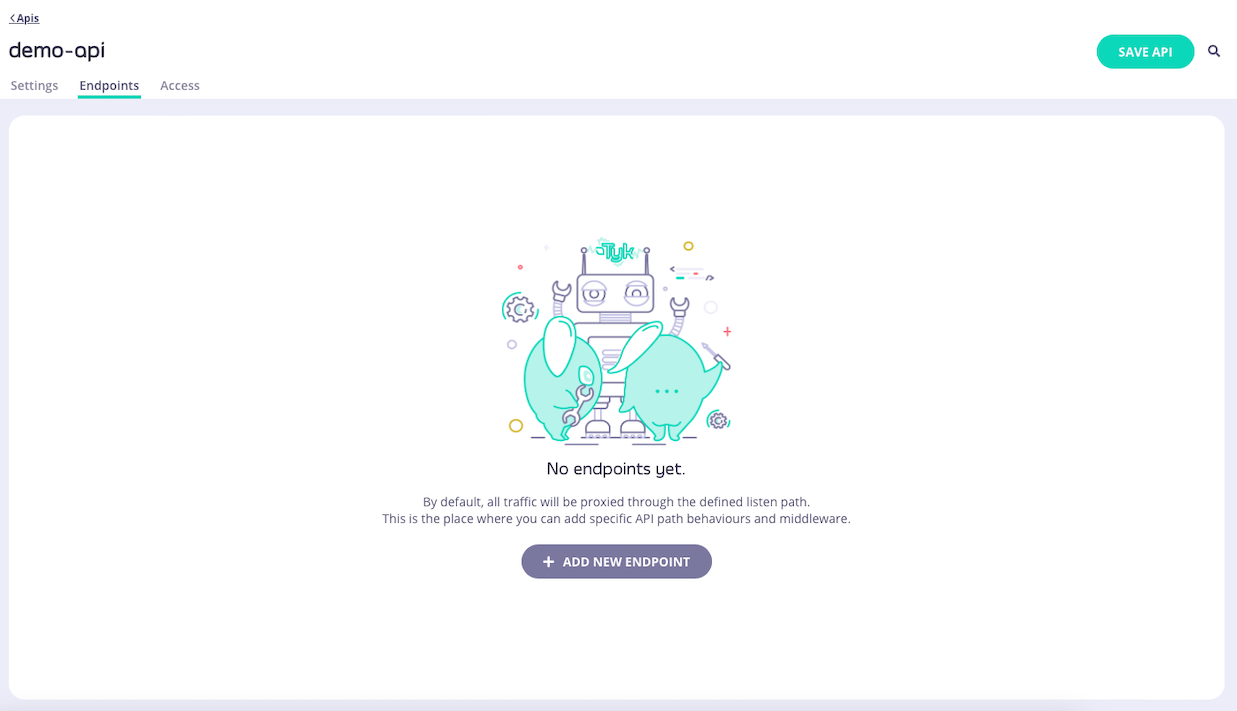
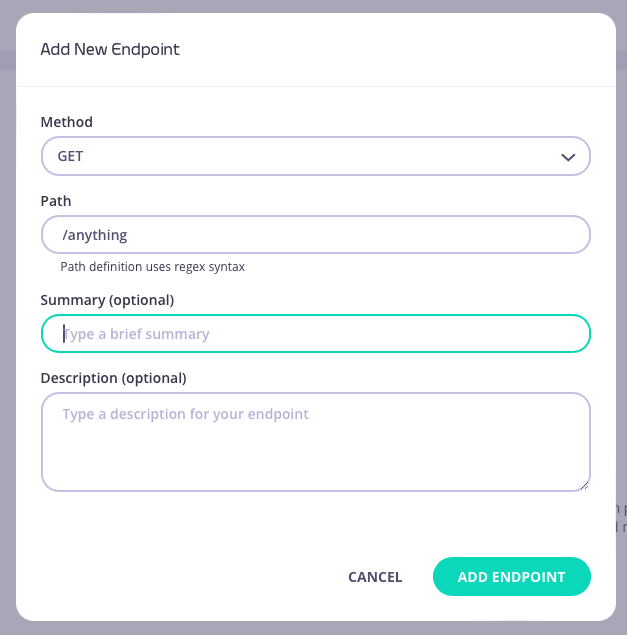
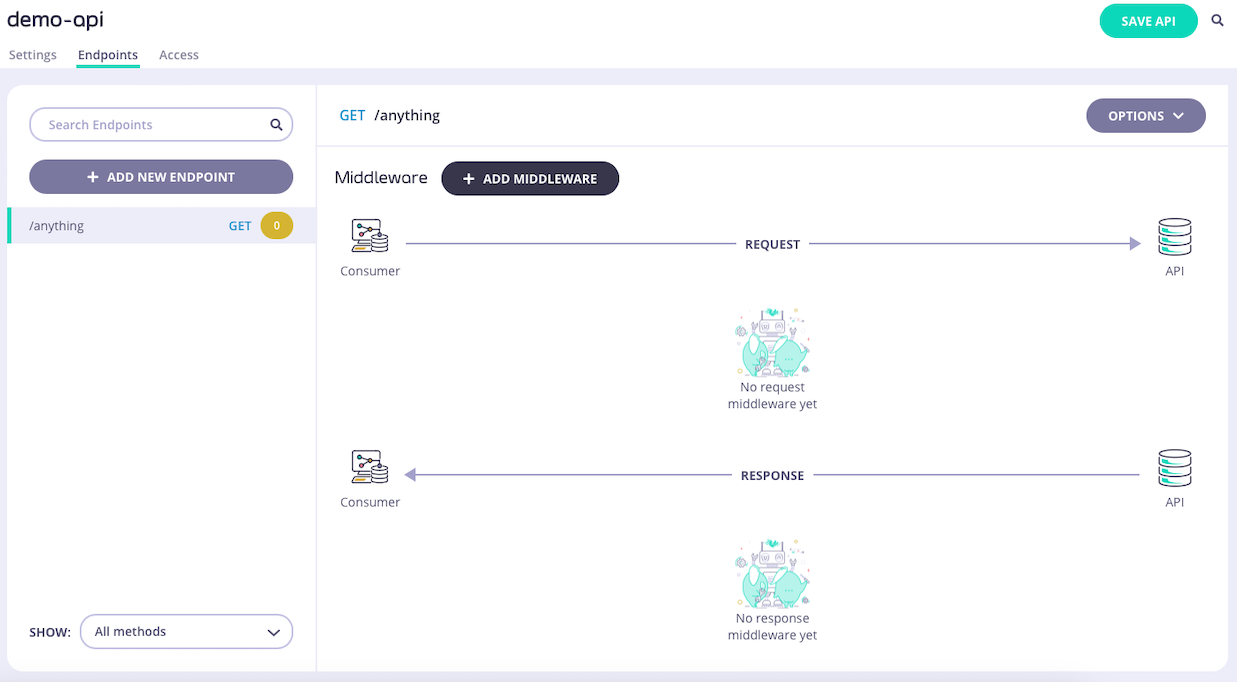
-
Select the Response Header Transform middleware
Select ADD MIDDLEWARE and choose the Response Header Transform middleware from the Add Middleware screen.
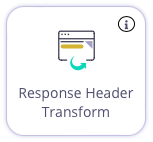
-
Configure header transformation
Select NEW HEADER to configure a header to be added to or removed from the response, you can add multiple headers to either list by selecting NEW HEADER again.


- Save the API Select ADD MIDDLEWARE to save the middleware configuration. Remember to select SAVE API to apply the changes.
Using Classic
Tyk’s response header transform middleware enables you to append or delete headers on responses received from the upstream service before sending them to the client. There are two options for this:- API-level modification that is applied to all responses for the API
-
endpoint-level modification that is applied only to responses from a specific endpoint
If both API-level and endpoint-level middleware are configured, the endpoint-level transformation will be applied first.
API Definition
The API-level and endpoint-level response header transforms have a common configuration but are configured in different sections of the API definition.Prior to Tyk 5.3.0, there was an additional step to enable response header transforms (both API-level and endpoint-level). You would need to add the following to the Tyk Classic API definition:If using the Endpoint Designer in the Tyk Dashboard, this would be added automatically.We removed the need to configure the
response_processors element in Tyk 5.3.0.API-level transform
To append headers to all responses from your API (i.e. for all endpoints) you must add a newglobal_response_headers object to the versions section of your API definition. This contains a list of key:value pairs, being the names and values of the headers to be added to responses.
To delete headers from all responses from your API (i.e. for all endpoints), you must add a new global_response_headers_remove object to the versions section of the API definition. This contains a list of the names of existing headers to be removed from responses.
For example:
X-Staticwith the valuefoobarX-Request-IDwith a dynamic value taken from therequest_idcontext variableX-User-IDwith a dynamic value taken from theuidfield in the session metadata
X-Secret
Endpoint-level transform
To configure response header transformation for a specific endpoint you must add a newtransform_response_headers object to the extended_paths section of your API definition.
It has the following configuration:
path: the endpoint pathmethod: the endpoint HTTP methoddelete_headers: a list of the headers that should be deleted from the responseadd_headers: a list of headers, in key:value pairs, that should be added to the response
GET requests to the /status/200 endpoint. Any response received from the upstream service following a request to that endpoint will have the X-Static header removed and the X-Secret and X-New headers added (with values set to the-secret-key-is-secret and another-header).
Combining API-level and Endpoint-level transforms
If the example API-level and endpoint-level transforms are applied to the same API, then theX-Secret header will be added (by the endpoint-level transform first) and then removed (by the API-level transform). Subsequently, the result of the two transforms for a call to GET /status/200 would be to add four headers:
X-Request-IDX-User-IDX-StaticX-New
Fixing response headers that leak upstream server data
A middleware calledheader_transform was added in Tyk 2.1 specfically to allow you to ensure that headers such as Location and Link reflect the outward facade of your API Gateway and also align with the expected response location to be terminated at the gateway, not the hidden upstream proxy.
This is configured by adding a new rev_proxy_header_cleanup object to the response_processors section of your API definition.
It has the following configuration:
headers: a list of headers in the response that should be modifiedtarget_host: the value to which the listed headers should be updated
Link and Location headers will be modified from the server-generated response, with the protocol, domain and port of the value set in target_host.
This feature is rarely used and has not been implemented in the Tyk Dashboard UI, nor in the Tyk OAS API.
API Designer
You can use the API Designer in the Tyk Dashboard to configure the response header transform middleware for your Tyk Classic API by following these steps.API-level transform
Configuring the API-level response header transform middleware is very simple when using the Tyk Dashboard. In the Endpoint Designer you should select the Global Version Settings and ensure that you have selected the Response Headers tab: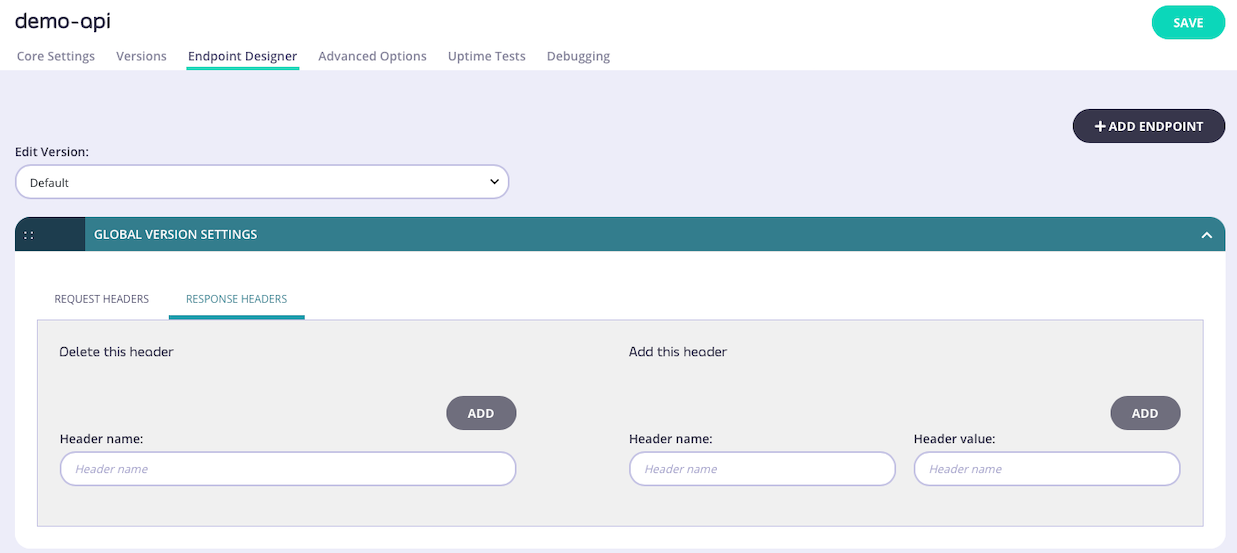
Endpoint-level transform
-
Add an endpoint for the path and select the Header Transform plugin
From the Endpoint Designer add an endpoint that matches the path for which you want to perform the transformation. Select the Modify Headers plugin.

-
Select the “Response” tab
This ensures that the transform will be applied to responses prior to them being sent to the client.

-
Declare the headers to be modified
Select the headers to delete and insert using the provided fields. You need to click ADD to ensure they are added to the list.
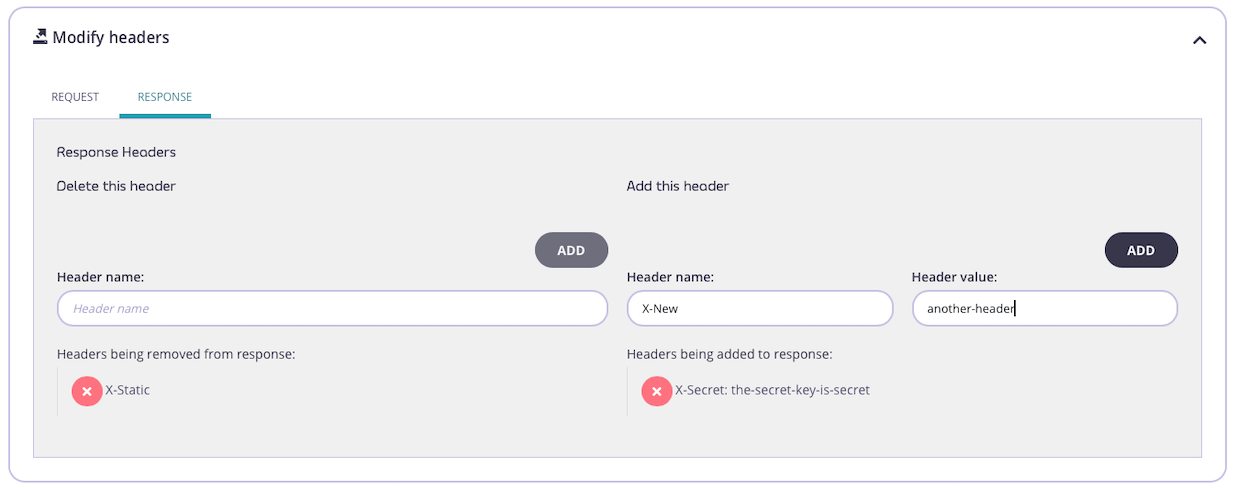
- Save the API Use the save or create buttons to save the changes and activate the middleware.
Tyk Operator
The process for configuring a response header transform in Tyk Operator is similar to that defined in section configuring the Response Header Transform in the Tyk Classic API Definition. Tyk Operator allows you to configure a response header transformation for all endpoints of an API or for a specific API endpoint.API-level transform
The process of configuring transformation of response headers for a specific API in Tyk Operator is similar to that defined in section API-level transform for the Tyk Classic API definition. To append headers to all responses from your API (i.e. for all endpoints) you must add a newglobal_response_headers object to the versions section of your API definition. This contains a list of key:value pairs, being the names and values of the headers to be added to responses.
To delete headers from all responses from your API (i.e. for all endpoints), you must add a new global_response_headers_remove object to the versions section of the API definition. This contains a list of the names of existing headers to be removed from responses.
An example is listed below:
/httpbin-global-header and forwards requests upstream to http://httpbin.org.
This configuration will add three new headers to each response:
X-Staticwith the valuefoobarX-Request-IDwith a dynamic value taken from therequest_idcontext variableX-User-IDwith a dynamic value taken from theuidfield in the session metadata
X-Secret
Endpoint-level transform
The process of configuring a transformation of a response header for a specific endpoint in Tyk Operator is similar to that defined in section endpoint-level transform for the Tyk Classic API definition. To configure a transformation of the response headers for a specific endpoint you must add a newtransform_response_headers object to the extended_paths section of your API definition.
In this example the Response Header Transform middleware (transform_response_headers) has been configured for HTTP GET requests to the /xml endpoint. Any response received from the upstream service following a request to that endpoint will have the Content-Type header added with a value set to application/json.
Example
Tyk Gateway < 5.3.0 Example
If using Tyk Gateway < v5.3.0 then aresponse_processor object must be added to the API definition containing a header_injector item, as highlighted below: